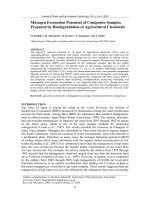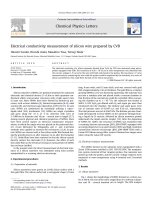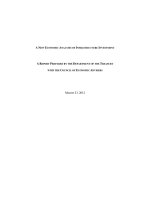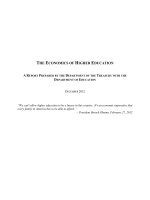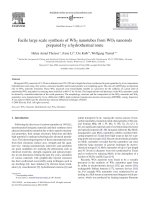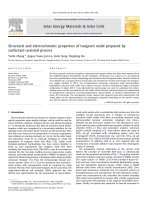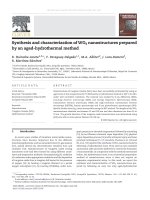Prepared by Asif Bhat Python Tutorial
Bạn đang xem bản rút gọn của tài liệu. Xem và tải ngay bản đầy đủ của tài liệu tại đây (1.38 MB, 170 trang )
8/19/2020
Asif - Jupyter Notebook
Prepared by Asif Bhat
Python Tutorial
In [103]: import sys
import keyword
import operator
from datetime import datetime
import os
Keywords
Keywords are the reserved words in Python and can't be used as an identifier
In [3]: print(keyword.kwlist) # List all Python Keywords
['False', 'None', 'True', 'and', 'as', 'assert', 'async', 'await', 'break', 'class', 'continue', 'def', 'del', 'elif',
'else', 'except', 'finally', 'for', 'from', 'global', 'if', 'import', 'in', 'is', 'lambda', 'nonlocal', 'not', 'or', 'p
ass', 'raise', 'return', 'try', 'while', 'with', 'yield']
In [4]: len(keyword.kwlist) # Python contains 35 keywords
Out[4]: 35
Identifiers
An identifier is a name given to entities like class, functions, variables, etc. It helps to differentiate one entity from another.
localhost:8888/notebooks/Documents/GitHub/Public/Python/Asif.ipynb
1/170
8/19/2020
Asif - Jupyter Notebook
In [13]: 1var = 10 # Identifier can't start with a digit
File "<ipython-input-13-37e58aaf2d3b>", line 1
1var = 10 # Identifier can't start with a digit
^
SyntaxError: invalid syntax
In [14]: val2@ = 35 # Identifier can't use special symbols
File "<ipython-input-14-cfbf60736601>", line 1
val2@ = 35 # Identifier can't use special symbols
^
SyntaxError: invalid syntax
In [15]: import = 125 # Keywords can't be used as identifiers
File "<ipython-input-15-f7061d4fc9ba>", line 1
import = 125 # Keywords can't be used as identifiers
^
SyntaxError: invalid syntax
In [16]: """
Correct way of defining an identifier
(Identifiers can be a combination of letters in lowercase (a to z) or uppercase (A to Z) or digits (0 to 9) or an undersc
"""
val2 = 10
In [17]: val_ = 99
Comments in Python
localhost:8888/notebooks/Documents/GitHub/Public/Python/Asif.ipynb
2/170
8/19/2020
Asif - Jupyter Notebook
Comments can be used to explain the code for more readabilty.
In [18]: # Single line comment
val1 = 10
In [19]: # Multiple
# line
# comment
val1 = 10
In [20]: '''
Multiple
line
comment
'''
val1 = 10
In [21]: """
Multiple
line
comment
"""
val1 = 10
Statements
Instructions that a Python interpreter can execute.
In [27]: # Single line statement
p1 = 10 + 20
p1
Out[27]: 30
localhost:8888/notebooks/Documents/GitHub/Public/Python/Asif.ipynb
3/170
8/19/2020
Asif - Jupyter Notebook
In [28]: # Single line statement
p2 = ['a' , 'b' , 'c' , 'd']
p2
Out[28]: ['a', 'b', 'c', 'd']
In [26]: # Multiple line statement
p1 = 20 + 30 \
+ 40 + 50 +\
+ 70 + 80
p1
Out[26]: 290
In [29]: # Multiple line statement
p2 = ['a' ,
'b' ,
'c' ,
'd'
]
p2
Out[29]: ['a', 'b', 'c', 'd']
Indentation
Indentation refers to the spaces at the beginning of a code line. It is very important as Python uses indentation to indicate a block of code.If the
indentation is not correct we will endup with IndentationError error.
In [37]: p = 10
if p == 10:
print ('P is equal to 10') # correct indentation
P is equal to 10
localhost:8888/notebooks/Documents/GitHub/Public/Python/Asif.ipynb
4/170
8/19/2020
Asif - Jupyter Notebook
In [38]: # if indentation is skipped we will encounter "IndentationError: expected an indented block"
p = 10
if p == 10:
print ('P is equal to 10')
File "<ipython-input-38-d7879ffaae93>", line 3
print ('P is equal to 10')
^
IndentationError: expected an indented block
In [39]: for i in range(0,5):
print(i)
# correct indentation
0
1
2
3
4
In [43]: # if indentation is skipped we will encounter "IndentationError: expected an indented block"
for i in range(0,5):
print(i)
File "<ipython-input-43-4a6de03bf63e>", line 2
print(i)
^
IndentationError: expected an indented block
In [45]: for i in range(0,5): print(i)
# correct indentation but less readable
0
1
2
3
4
localhost:8888/notebooks/Documents/GitHub/Public/Python/Asif.ipynb
5/170
8/19/2020
Asif - Jupyter Notebook
In [48]: j=20
for i in range(0,5):
print(i) # inside the for loop
print(j) # outside the for loop
0
1
2
3
4
20
Docstrings
1) Docstrings provide a convenient way of associating documentation with functions, classes, methods or modules.
2) They appear right after the definition of a function, method, class, or module.
In [49]: def square(num):
'''Square Function :- This function will return the square of a number'''
return num**2
In [51]: square(2)
Out[51]: 4
In [52]: square.__doc__
# We can access the Docstring using __doc__ method
Out[52]: 'Square Function :- This function will return the square of a number'
In [53]: def evenodd(num):
'''evenodd Function :- This function will test whether a numbr is Even or Odd'''
if num % 2 == 0:
print("Even Number")
else:
print("Odd Number")
localhost:8888/notebooks/Documents/GitHub/Public/Python/Asif.ipynb
6/170
8/19/2020
Asif - Jupyter Notebook
In [54]: evenodd(3)
Odd Number
In [55]: evenodd(2)
Even Number
In [56]: evenodd.__doc__
Out[56]: 'evenodd Function :- This function will test whether a numbr is Even or Odd'
Variables
A Python variable is a reserved memory location to store values.A variable is created the moment you first assign a value to it.
In [75]: p = 30
In [76]: '''
id() function returns the “identity” of the object.
The identity of an object - Is an integer
- Guaranteed to be unique
- Constant for this object during its lifetime.
'''
id(p)
Out[76]: 140735029552432
In [77]: hex(id(p)) # Memory address of the variable
Out[77]: '0x7fff6d71a530'
localhost:8888/notebooks/Documents/GitHub/Public/Python/Asif.ipynb
7/170
8/19/2020
In [94]: p
q
r
p
Asif - Jupyter Notebook
=
=
=
,
20 #Creates an integer object with value 20 and assigns the variable p to point to that object.
20 # Create new reference q which will point to value 20. p & q will be pointing to same memory location.
q # variable r will also point to the same location where p & q are pointing/
type(p), hex(id(p)) # Variable P is pointing to memory location '0x7fff6d71a3f0' where value 20 is stored
Out[94]: (20, int, '0x7fff6d71a3f0')
In [95]: q , type(q), hex(id(q))
Out[95]: (20, int, '0x7fff6d71a3f0')
In [96]: r , type(r), hex(id(r))
Out[96]: (20, int, '0x7fff6d71a3f0')
localhost:8888/notebooks/Documents/GitHub/Public/Python/Asif.ipynb
8/170
8/19/2020
Asif - Jupyter Notebook
In [146]: p = 20
p = p + 10 # Variable Overwriting
p
Out[146]: 30
Variable Assigment
In [100]: intvar = 10 # Integer variable
floatvar = 2.57 # Float Variable
strvar = "Python Language" # String variable
print(intvar)
print(floatvar)
print(strvar)
10
2.57
Python Language
Multiple Assignments
In [102]: intvar , floatvar , strvar = 10,2.57,"Python Language" # Using commas to separate variables and their corresponding value
print(intvar)
print(floatvar)
print(strvar)
10
2.57
Python Language
In [105]: p1 = p2 = p3 = p4 = 44 # All variables pointing to same value
print(p1,p2,p3,p4)
44 44 44 44
localhost:8888/notebooks/Documents/GitHub/Public/Python/Asif.ipynb
9/170
8/19/2020
Asif - Jupyter Notebook
Data Types
Numeric
In [135]: val1 = 10 # Integer data type
print(val1)
print(type(val1)) # type of object
print(sys.getsizeof(val1)) # size of integer object in bytes
print(val1, " is Integer?", isinstance(val1, int)) # val1 is an instance of int class
10
<class 'int'>
28
10 is Integer? True
In [126]: val2 = 92.78 # Float data type
print(val2)
print(type(val2)) # type of object
print(sys.getsizeof(val2)) # size of float object in bytes
print(val2, " is float?", isinstance(val2, float)) # Val2 is an instance of float class
92.78
<class 'float'>
24
92.78 is float? True
In [136]: val3 = 25 + 10j # Complex data type
print(val3)
print(type(val3)) # type of object
print(sys.getsizeof(val3)) # size of float object in bytes
print(val3, " is complex?", isinstance(val3, complex)) # val3 is an instance of complex class
(25+10j)
<class 'complex'>
32
(25+10j) is complex? True
localhost:8888/notebooks/Documents/GitHub/Public/Python/Asif.ipynb
10/170
8/19/2020
Asif - Jupyter Notebook
In [119]: sys.getsizeof(int()) # size of integer object in bytes
Out[119]: 24
In [120]: sys.getsizeof(float())
# size of float object in bytes
Out[120]: 24
In [138]: sys.getsizeof(complex()) # size of complex object in bytes
Out[138]: 32
Boolean
Boolean data type can have only two possible values true or false.
In [139]: bool1 = True
In [140]: bool2 = False
In [143]: print(type(bool1))
<class 'bool'>
In [144]: print(type(bool2))
<class 'bool'>
In [148]: isinstance(bool1, bool)
Out[148]: True
In [235]: bool(0)
Out[235]: False
localhost:8888/notebooks/Documents/GitHub/Public/Python/Asif.ipynb
11/170
8/19/2020
Asif - Jupyter Notebook
In [236]: bool(1)
Out[236]: True
In [237]: bool(None)
Out[237]: False
In [238]: bool (False)
Out[238]: False
Strings
String Creation
In [193]: str1 = "HELLO PYTHON"
print(str1)
HELLO PYTHON
In [194]: mystr = 'Hello World' # Define string using single quotes
print(mystr)
Hello World
In [195]: mystr = "Hello World" # Define string using double quotes
print(mystr)
Hello World
localhost:8888/notebooks/Documents/GitHub/Public/Python/Asif.ipynb
12/170
8/19/2020
Asif - Jupyter Notebook
In [196]: mystr = '''Hello
World '''
print(mystr)
# Define string using triple quotes
Hello
World
In [197]: mystr = """Hello
World"""
print(mystr)
# Define string using triple quotes
Hello
World
In [198]: mystr = ('Happy '
'Monday '
'Everyone')
print(mystr)
Happy Monday Everyone
In [199]: mystr2 = 'Woohoo '
mystr2 = mystr2*5
mystr2
Out[199]: 'Woohoo Woohoo Woohoo Woohoo Woohoo '
In [200]: len(mystr2) # Length of string
Out[200]: 35
String Indexing
localhost:8888/notebooks/Documents/GitHub/Public/Python/Asif.ipynb
13/170
8/19/2020
Asif - Jupyter Notebook
In [201]: str1
Out[201]: 'HELLO PYTHON'
In [202]: str1[0] # First character in string "str1"
Out[202]: 'H'
In [203]: str1[len(str1)-1] # Last character in string using len function
Out[203]: 'N'
In [204]: str1[-1] # Last character in string
Out[204]: 'N'
In [205]: str1[6] #Fetch 7th element of the string
Out[205]: 'P'
localhost:8888/notebooks/Documents/GitHub/Public/Python/Asif.ipynb
14/170
8/19/2020
Asif - Jupyter Notebook
In [206]: str1[5]
Out[206]: ' '
String Slicing
In [207]: str1[0:5] # String slicing - Fetch all characters from 0 to 5 index location excluding the character at loc 5.
Out[207]: 'HELLO'
In [208]: str1[6:12] # String slicing - Retreive all characters between 6 - 12 index loc excluding index loc 12.
Out[208]: 'PYTHON'
In [209]: str1[-4:] # Retreive last four characters of the string
Out[209]: 'THON'
In [210]: str1[-6:] # Retreive last six characters of the string
Out[210]: 'PYTHON'
In [211]: str1[:4] # Retreive first four characters of the string
Out[211]: 'HELL'
In [212]: str1[:6] # Retreive first six characters of the string
Out[212]: 'HELLO '
Update & Delete String
In [213]: str1
Out[213]: 'HELLO PYTHON'
localhost:8888/notebooks/Documents/GitHub/Public/Python/Asif.ipynb
15/170
8/19/2020
Asif - Jupyter Notebook
In [214]: #Strings are immutable which means elements of a string cannot be changed once they have been assigned.
str1[0:5] = 'HOLAA'
--------------------------------------------------------------------------TypeError
Traceback (most recent call last)
<ipython-input-214-ea670ff3ec72> in <module>
1 #Strings are immutable which means elements of a string cannot be changed once they have been assigned.
----> 2 str1[0:5] = 'HOLAA'
TypeError: 'str' object does not support item assignment
In [215]: del str1 # Delete a string
print(srt1)
--------------------------------------------------------------------------NameError
Traceback (most recent call last)
<ipython-input-215-7fcc0cc83dcc> in <module>
1 del str1 # Delete a string
----> 2 print(srt1)
NameError: name 'srt1' is not defined
String concatenation
In [216]: # String concatenation
s1 = "Hello"
s2 = "Asif"
s3 = s1 + s2
print(s3)
HelloAsif
localhost:8888/notebooks/Documents/GitHub/Public/Python/Asif.ipynb
16/170
8/19/2020
Asif - Jupyter Notebook
In [217]: # String concatenation
s1 = "Hello"
s2 = "Asif"
s3 = s1 + " " + s2
print(s3)
Hello Asif
Iterating through a String
In [218]: mystr1 = "Hello Everyone"
In [219]: # Iteration
for i in mystr1:
print(i)
H
e
l
l
o
E
v
e
r
y
o
n
e
localhost:8888/notebooks/Documents/GitHub/Public/Python/Asif.ipynb
17/170
8/19/2020
Asif - Jupyter Notebook
In [220]: for i in enumerate(mystr1):
print(i)
(0, 'H')
(1, 'e')
(2, 'l')
(3, 'l')
(4, 'o')
(5, ' ')
(6, 'E')
(7, 'v')
(8, 'e')
(9, 'r')
(10, 'y')
(11, 'o')
(12, 'n')
(13, 'e')
In [221]: list(enumerate(mystr1)) # Enumerate method adds a counter to an iterable and returns it in a form of enumerate object.
Out[221]: [(0, 'H'),
(1, 'e'),
(2, 'l'),
(3, 'l'),
(4, 'o'),
(5, ' '),
(6, 'E'),
(7, 'v'),
(8, 'e'),
(9, 'r'),
(10, 'y'),
(11, 'o'),
(12, 'n'),
(13, 'e')]
String Membership
localhost:8888/notebooks/Documents/GitHub/Public/Python/Asif.ipynb
18/170
8/19/2020
Asif - Jupyter Notebook
In [222]: # String membership
mystr1 = "Hello Everyone"
print ('Hello' in mystr1) # Check whether substring "Hello" is present in string "mysrt1"
print ('Everyone' in mystr1) # Check whether substring "Everyone" is present in string "mysrt1"
print ('Hi' in mystr1) # Check whether substring "Hi" is present in string "mysrt1"
True
True
False
String Partitioning
In [256]: """
The partition() method searches for a specified string and splits the string into a tuple containing three elements.
- The first element contains the part before the argument string.
- The second element contains the argument string.
- The third element contains the part after the argument string.
"""
str5 = "Natural language processing with Python and R and Java"
L = str5.partition("and")
print(L)
('Natural language processing with Python ', 'and', ' R and Java')
localhost:8888/notebooks/Documents/GitHub/Public/Python/Asif.ipynb
19/170
8/19/2020
Asif - Jupyter Notebook
In [257]: """
The rpartition() method searches for the last occurence of the specified string and splits the string into a tuple
containing three elements.
- The first element contains the part before the argument string.
- The second element contains the argument string.
- The third element contains the part after the argument string.
"""
str5 = "Natural language processing with Python and R and Java"
L = str5.rpartition("and")
print(L)
('Natural language processing with Python and R ', 'and', ' Java')
String Functions
In [267]: mystr2 = "
mystr2
Out[267]: '
Hello Everyone
Hello Everyone
"
'
In [268]: mystr2.strip() # Removes white space from begining & end
Out[268]: 'Hello Everyone'
In [270]: mystr2.rstrip() # Removes all whitespaces at the end of the string
Out[270]: '
Hello Everyone'
In [269]: mystr2.lstrip() # Removes all whitespaces at the begining of the string
Out[269]: 'Hello Everyone
'
localhost:8888/notebooks/Documents/GitHub/Public/Python/Asif.ipynb
20/170
8/19/2020
Asif - Jupyter Notebook
In [272]: mystr2 = "*********Hello Everyone***********All the Best**********"
mystr2
Out[272]: '*********Hello Everyone***********All the Best**********'
In [273]: mystr2.strip('*') # Removes all '*' characters from begining & end of the string
Out[273]: 'Hello Everyone***********All the Best'
In [274]: mystr2.rstrip('*') # Removes all '*' characters at the end of the string
Out[274]: '*********Hello Everyone***********All the Best'
In [275]: mystr2.lstrip('*') # Removes all '*' characters at the begining of the string
Out[275]: 'Hello Everyone***********All the Best**********'
In [276]: mystr2 = "
Hello Everyone
"
In [277]: mystr2.lower() # Return whole string in lowercase
Out[277]: '
hello everyone
'
In [278]: mystr2.upper() # Return whole string in uppercase
Out[278]: '
HELLO EVERYONE
'
In [279]: mystr2.replace("He" , "Ho") #Replace substring "He" with "Ho"
Out[279]: '
Hollo Everyone
'
In [280]: mystr2.replace(" " , "") # Remove all whitespaces using replace function
Out[280]: 'HelloEveryone'
In [281]: mystr5 = "one two Three one two two three"
localhost:8888/notebooks/Documents/GitHub/Public/Python/Asif.ipynb
21/170
8/19/2020
Asif - Jupyter Notebook
In [230]: mystr5.count("one") # Number of times substring "one" occurred in string.
Out[230]: 2
In [231]: mystr5.count("two") # Number of times substring "two" occurred in string.
Out[231]: 3
In [232]: mystr5.startswith("one")
# Return boolean value True if string starts with "one"
Out[232]: True
In [233]: mystr5.endswith("three") # Return boolean value True if string ends with "three"
Out[233]: True
In [234]: mystr4 = "one two three four one two two three five five six seven six seven one one one ten eight ten nine eleven ten te
localhost:8888/notebooks/Documents/GitHub/Public/Python/Asif.ipynb
22/170
8/19/2020
Asif - Jupyter Notebook
In [235]: mylist = mystr4.split() # Split String into substrings
mylist
Out[235]: ['one',
'two',
'three',
'four',
'one',
'two',
'two',
'three',
'five',
'five',
'six',
'seven',
'six',
'seven',
'one',
'one',
'one',
'ten',
'eight',
'ten',
'nine',
'eleven',
'ten',
'ten',
'nine']
In [236]: # Combining string & numbers using format method
item1 = 40
item2 = 55
item3 = 77
res = "Cost of item1 , item2 and item3 are {} , {} and {}"
print(res.format(item1,item2,item3))
Cost of item1 , item2 and item3 are 40 , 55 and 77
localhost:8888/notebooks/Documents/GitHub/Public/Python/Asif.ipynb
23/170
8/19/2020
Asif - Jupyter Notebook
In [237]: # Combining string & numbers using format method
item1 = 40
item2 = 55
item3 = 77
res = "Cost of item3 , item2 and item1 are {2} , {1} and {0}"
print(res.format(item1,item2,item3))
Cost of item3 , item2 and item1 are 77 , 55 and 40
In [238]: str2 = " WELCOME EVERYONE "
str2 = str2.center(100) # center align the string using a specific character as the fill character.
print(str2)
WELCOME EVERYONE
In [239]: str2 = " WELCOME EVERYONE "
str2 = str2.center(100,'*') # center align the string using a specific character ('*') as the fill character.
print(str2)
***************************************** WELCOME EVERYONE *****************************************
In [240]: str2 = " WELCOME EVERYONE "
str2 = str2.rjust(50) # Right align the string using a specific character as the fill character.
print(str2)
WELCOME EVERYONE
In [241]: str2 = " WELCOME EVERYONE "
str2 = str2.rjust(50,'*') # Right align the string using a specific character ('*') as the fill character.
print(str2)
******************************** WELCOME EVERYONE
localhost:8888/notebooks/Documents/GitHub/Public/Python/Asif.ipynb
24/170
8/19/2020
Asif - Jupyter Notebook
In [242]: str4 = "one two three four five six seven"
loc = str4.find("five") # Find the location of word 'five' in the string "str4"
print(loc)
19
In [243]: str4 = "one two three four five six seven"
loc = str4.index("five") # Find the location of word 'five' in the string "str4"
print(loc)
19
In [244]: mystr6 = '123456789'
print(mystr6.isalpha()) # returns True if all the characters in the text are letters
print(mystr6.isalnum()) # returns True if a string contains only letters or numbers or both
print(mystr6.isdecimal()) # returns True if all the characters are decimals (0-9)
print(mystr6.isnumeric()) # returns True if all the characters are numeric (0-9)
False
True
True
True
In [245]: mystr6 = 'abcde'
print(mystr6.isalpha()) # returns True if all the characters in the text are letters
print(mystr6.isalnum()) # returns True if a string contains only letters or numbers or both
print(mystr6.isdecimal()) # returns True if all the characters are decimals (0-9)
print(mystr6.isnumeric()) # returns True if all the characters are numeric (0-9)
True
True
False
False
localhost:8888/notebooks/Documents/GitHub/Public/Python/Asif.ipynb
25/170
